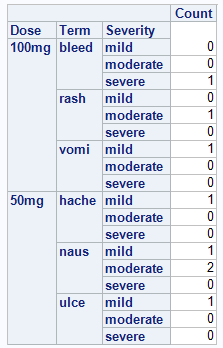- Home
- /
- Programming
- /
- Programming
- /
- How to have obs with zero values when the data does not exsit
- RSS Feed
- Mark Topic as New
- Mark Topic as Read
- Float this Topic for Current User
- Bookmark
- Subscribe
- Mute
- Printer Friendly Page
- Mark as New
- Bookmark
- Subscribe
- Mute
- RSS Feed
- Permalink
- Report Inappropriate Content
Dear,
After running the below program the output i got is(Document attached). But I need to have in my outdata inaddition to the output is
eg;
for dose='100mg' and term='bleed' and sev='severe' there is only one obs in the output. I need to have obs with zero values for all SEV variable values for all OBS.
Please help in my code. Thank you
eg: output needed for a obs:
term sev 50 100
bleed mild 0 0
bleed moderate 0 0
bleed severe 0 1
output getting
term sev 50 100
bleed severe 0 1
data one;
input id dose $ term $ sev $;
datalines;
1 50mg hache mild
2 50mg naus moderate
3 100mg vomi mild
4 50mg ulce mild
5 100mg bleed severe
6 100mg rash moderate
7 50mg naus moderate
8 50mg naus mild
;
proc sql;
create table two as
select count(distinct ID) as NS,dose,term,sev
from one
group by dose,term,sev;
quit;
proc sort data=two;
by dose term sev;
run;
proc transpose data=two out=three(drop=_NAME_);
by dose term sev ;
var NS;
id dose;
run;
data four;
set three;
array data _50mg _100mg;
do over data;
if missing(data) then data=0;
end;
TOTAL= _50mg + _100mg ;
run;
- Mark as New
- Bookmark
- Subscribe
- Mute
- RSS Feed
- Permalink
- Report Inappropriate Content
Your current method results in separate lines for each dose, thus the totals do not reflect the 50mg+100mg totals.
There may be a more efficient way, but I think that the following does what you want:
data one;
input id dose $ term $ sev $;
datalines;
1 50mg hache mild
2 50mg naus moderate
3 100mg vomi mild
4 50mg ulce mild
5 100mg bleed severe
6 100mg rash moderate
7 50mg naus moderate
8 50mg naus mild
;
proc sql noprint;
create table doses as
select distinct dose
from one
;
create table terms as
select distinct term
from one
;
create table sevs as
select distinct sev
from one
;
create table comb as
select *, . as NS
from doses,terms,sevs
order by term,sev,dose
;
quit;
proc sql;
create table two as
select count(distinct ID) as NS,dose,term,sev
from one
group by term,sev,dose
;
quit;
data two;
update two comb;
by term sev dose;
run;
proc transpose data=two out=three(drop=_NAME_);
by term sev;
var NS;
id dose;
run;
data four;
set three;
array data _50mg _100mg;
do over data;
if missing(data) then data=0;
end;
TOTAL= _50mg + _100mg ;
run;
Art, CEO, AnalystFinder.com
- Mark as New
- Bookmark
- Subscribe
- Mute
- RSS Feed
- Permalink
- Report Inappropriate Content
In case you're just after some sort of report then the following could do:
data one;
input id dose $ term $ sev $;
datalines;
1 50mg hache mild
2 50mg naus moderate
3 100mg vomi mild
4 50mg ulce mild
5 100mg bleed severe
6 100mg rash moderate
7 50mg naus moderate
8 50mg naus mild
;
run;
proc sql;
create table combinations as
select distinct t1.dose, t1.term, t2.sev
from
one as t1, (select distinct sev from one) as t2
order by t1.dose, t1.term, t2.sev
;
quit;
options missing='0';
proc tabulate data=one classdata=combinations;
class dose term sev;
table
dose='Dose'*term='Term'*sev='Severity',
n='Count'
;
run;
- Mark as New
- Bookmark
- Subscribe
- Mute
- RSS Feed
- Permalink
- Report Inappropriate Content
If I understand you correctly, you want to have the output for all possible combinations of DOSE, TERM, and SEV, also those that have no observations.
One way to do this is to use PROC FREQ with the SPARSE options:
proc freq data=one; tables dose*term*sev/noprint sparse out=two(drop=percent); run;
which will give you an exploded version of your TWO table, with all possible combinations.
April 27 – 30 | Gaylord Texan | Grapevine, Texas
Registration is open
Walk in ready to learn. Walk out ready to deliver. This is the data and AI conference you can't afford to miss.
Register now and lock in 2025 pricing—just $495!
Learn how use the CAT functions in SAS to join values from multiple variables into a single value.
Find more tutorials on the SAS Users YouTube channel.
SAS Training: Just a Click Away
Ready to level-up your skills? Choose your own adventure.



